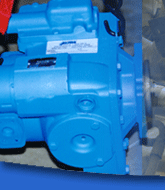

Steel/Aluminum
Although steel and related raw materials are considered commodities,
they are by no means standardized material; for instance, every piece
of steel varies in dimension, weight and quality. One major area for hydraulic
controls in the steel manufacturing industry is the (HAGC) Hydraulic Automatic
Gage Control System.
The purpose of an HAGC system in the finishing train of a hot strip mill
is to maintain uniform product thickness in spite of factors that act
to vary that thickness. The major factors are varying material hardness
(mostly from varying temperature), varying thickness in the incoming product
(from the roughing area), varying unloaded roll bite size due to roll
stack eccentricity. Additional sources of disturbance such as incoming
product width variation, or variations in inter-stand tension are usually
already within acceptable limits in a well-managed mill. Modern HAGC systems
perform in an excellent fashion to counteract these major deterring factors.
Most HAGC systems accomplish this using closed loop servocontrolled cylinders.
There are several processes in the manufacturing of steel which have fluid power products some are listed below:
Reheating Furnace
Slabs transferred from the continuous casting mill enter the rolling process
after they are fully heated in the reheating furnace. A vertical scale
breaker (VSB) eliminates the thick scale formed on the slab surface during
hot rolling. Some reheating furnaces have servovalves which are sold and
serviced by ServoCon ALPHA.
Roughing Mill
In this stage, slabs with surface scale already removed are made into
rolling material with appropriate shape, thickness, and width. The edger
at the entry and exit of the mill rolls the slabs in crosswise direction
using the automatic width control (AWC) system which in some cases is
hydraulically controlled.
Finishing Mill
Finishing mill adjusts the slab thickness and width to specification.
It also rolls the slabs at a suitable finishing temperature so that smooth
surface and proper shape can be attained. The cutting-edge work roll shift,
pair cross mill, and on-line rolling grinder (ORG) control the crown,
improving both productivity and quality.
Run-Out Table and Coiler
After the finishing mill, the strip passes through the run-out table where
it is then coiled. While passing through the table, the strip is sprayed
with water to cool it down to a suitable coiling temperature.
Recoiling Line
Inspections for surface defects, shape, and size specification are conducted
during this stage to enhance product shape, mechanical properties, and
surface roughness.
These processes have hydraulic components to do the hard work it takes to process high tolerance production steel. When high horse power is needed to shape and move steel production, hydraulic controls are an efficient, easy to maintain and dependable way to do it.
Aluminum production is hydraulically controlled in much the same way: therefore, many of the processes and equipment are used to form the many thicknesses, widths and rolls.
| Home | Markets | Product Solutions | Corporate | Customer Support | Downloads | What's New | Contact Us |